Chapter 1 In the population, blood pressure is a continuous, normally distributed variable. No separate subgroups of people with and without hypertension exist. A consistent continuous gradient exists between usual levels of blood pressure and the risk of coronary heart disease and stroke, and this gradient continues down to blood pressures that are well below the average for the population (Figure 1.1). Above blood pressures of 115/70 mmHg, the risk of developing cardiovascular events doubles for every 20/10mmHg rise in blood pressure. This means that much of the burden of renal disease and cardiovascular disease (CVD) related to blood pressure can be attributed to blood pressures within the so-called ‘normotensive’ or average range for Western populations. Most cardiovascular events are therefore blood pressure-related rather than hypertension-related. Figure 1.1 The distribution of diastolic blood pressure in the general population, the risk of cardiovascular disease (CVD) and the number of people who develop CVD. The main concern for clinicians is what level of blood pressure needs drug treatment. The pragmatic definition of hypertension is the level of blood pressure at which treatment is worthwhile. This level varies from patient to patient and balances the risks of untreated hypertension in different types of patients and the known benefits of reducing blood pressure, while taking into account the disadvantages of taking drugs and the likelihood of side effects. ‘In an operational sense, hypertension should be defined in terms of a blood pressure level above which investigation and treatment do more good than harm.’ Grimley Evans J, Rose G. Hypertension. Br Med Bull1971;27:37–42 Systolic blood pressure continues to rise with advancing age, so the prevalence of hypertension (and its complications) also increases with age. By contrast, diastolic pressures tend to level off at the age of about 50 years and tend to decline thereafter (Figure 1.2). Figure 1.2 Average systolic and diastolic blood pressures in men and women in the Birmingham Factory Screening Project. This figure excludes 165 patients who were receiving antihypertensive drugs. Source: Reproduced with permission from Lane, D.A., et al. (2002) Journal of Human Hypertension, 16, 267–273.© Nature Publishing. Hypertension thus is as much a disorder of populations as of individual people. Globally, high blood pressure and its vascular consequences, heart attack and stroke, account for more deaths than any other common medical condition and is a major burden of disease (Figure 1.3). Figure 1.3 Worldwide causes of death in 2002 in millions. CKD: chronic kidney disease. Source: Adapted from Mackay, J., & Mensah, G.A. (2004) The Atlas of Heart Disease and Stroke. World Health Organisation, Geneva. As hypertension is the most important risk factor for CVD, achievement of a universal target systolic blood pressure of 140 mm Hg or less should produce a reduction of 28–44% in the incidence of stroke and 20–35% of coronary heart disease. This could prevent about 21 400 deaths from stroke and 41 400 deaths from coronary heart disease in the United Kingdom each year. It would also mean about 42 800 fewer fatal and nonfatal strokes and 82 800 fewer coronary heart disease events per year in the United Kingdom alone. Globally, as hypertension is becoming more common, coronary heart disease and stroke correspondingly are becoming common, particularly in developing countries. A recently published analysis of pooled data from different regions of the world estimated the overall prevalence and absolute burden of hypertension in 2000 and the global burden in 2025. Overall, 26.4% of the adult population in 2000 had hypertension and 29.2% were projected to have this condition by 2025. The estimated total number of adults with hypertension in 2000 was 972 million: 333 million in economically developed countries and 639 million in economically developing countries. The number of adults with hypertension in 2025 is thus predicted to increase by about 60% to a total of 156 billion. The development of hypertension reflects a complex and dynamic interaction between genetic and environmental factors. In some primitive communities in which obesity is rare and salt intake is low, hypertension is virtually unknown, and blood pressure does not increase with advancing age. Studies have investigated Japanese people migrating from Japan to the west coast of America. In Japan, high blood pressure is common and the incidence of stroke is high, but coronary heart disease is rare. When Japanese people migrated across the Pacific Ocean to California, a reduction in the prevalence of hypertension and stroke was seen, but the prevalence of coronary heart disease (CHD) increased. These studies strongly suggest that, although racial differences exist in the predisposition to hypertension, environmental factors still play a significant role. The United Kingdom also has a pronounced north−south gradient in blood pressure, with pressures higher in the north of the country. Studies that compare urban and rural populations in African populations also show clear differences in blood pressure between urban and rural societies with the same genetic composition. In the United Kingdom, hypertension accounts for approximately 12% of Primary Care consultation episodes and approximately £1 billion in drug costs in 2006. The diagnosis, treatment and follow-up of patients with hypertension is one of the most common interventions in primary care, particularly since the National Service Frameworks for CVD prevention includes routine screening for hypertension. Depending on age, in up to 5% of people with hypertension in the general population depends on the arbitrary criteria used for its definition, as well as the population studied. In 2853 participants in the Birmingham Factory Screening Project, the odds ratios for being hypertensive after adjustment for age were 1.56 and 2.40 for African-Caribbean men and women, respectively, and 1.31 for South Asian men compared with Europeans (Table 1.1). Table 1.1 The prevalence of hypertension (≥160/95) in three ethnic groups in the Birmingham Factory Screening Project. Insufficient numbers of South Asian women were examined to provide meaningful prevalence rates The Third National Health and Nutrition Examination Survey 1988–91 (NHANES III) showed that 24% of the adult population in the United States, which represents more than 43 million people, have hypertension (>140/90 mm Hg or receiving treatment for hypertension). The prevalence of hypertension varied from 4% in people aged 18–29 years to 65% in people older than 80 years. Prevalence is higher among men than women, and the prevalence in African-Americans is higher than in Caucasians and Mexican-Americans (32.4, 23.3 and 22.6%, respectively). Most cases of hypertension in young adults result from increases in diastolic blood pressure, whereas in elderly people, isolated increases in systolic blood pressure are more common and account for 60% of cases of hypertension in men and 70% in women (Figure 1.4). Hypertension generally affects ≤10% of the population up to the age of 34 years. By the age of 65, however, more than half of the population has hypertension. Figure 1.4 Frequency distribution of untreated hypertensive individuals by age and hypertension subtype. Numbers at the top of bars represent the overall percentage distribution of all subtypes of untreated hypertension in that age group. Purple boxes, isolated systolic hypertension (ISH, SBP ≥140 mm Hg and DBP <90 mm Hg); Blue boxes, systo-diastolic hypertension (SDH, SBP ≥140 mm Hg and DBP ≥90 mm Hg), Red boxes, isolated diastolic hypertension (IDH, SBP <140 mm Hg and DBP ≥90 mm Hg). Source: Reproduced with permission from Franklin, S.S., et al. (2001) Hypertension, 37, 869–874. © Lippincott Williams & Wilkins. In the Health Survey for England, hypertension (systolic BP ≥ 140 mm Hg and/or Diastolic BP ≥ 90 mm Hg) was found to be prevalent in roughly 20% of 30–32-year olds, 30% of 30–40 year olds, 40% of 40–50 year olds and so on (Figure 1.5). Figure 1.5 The prevalence of hypertension in England 2010. Health Survey for England. Source: Adapted from McCormack, T., et al. (2013) British Journal of Cardiology, 20 (Suppl 1), S3–S15. © Health and Social Care Information Centre. Few data are available on the incidence of new onset hypertension. The incidence of hypertension does increase sharply with age, with higher rates in men. Follow up of people in the Framingham Heart Study after 30 years found that the 2-year incidence of new onset hypertension increases from 3.3% in men and 1.5% in women aged 30–39 years to 6.2% in men and 8.6% in women aged 70–79 years. People with ‘high-normal’ blood pressure at first examination were at greater risk of developing sustained hypertension over the ensuing years (Figure 1.6). Some authorities argue controversially that people with high-normal blood pressure should be classified or labelled as ‘pre-hypertensive’. Figure 1.6 Progression to develop new-onset hypertension in the Framingham Heart Study. Source: Reproduced with permission from Vasan, R.S., et al. (2001) Lancet, 358, 1682–1686. © Elsevier. ‘High-normal’ blood pressure is one of the strongest predictors for the later development of hypertension. At the individual level, however, blood pressure in childhood is poorly predictive of later levels of blood pressure or the risk of hypertension. In western societies, blood pressure increases with increasing age, and people with high baseline blood pressures have a faster increase than those with normal or below average pressures. In rural non-Westernised societies, however, hypertension is rare, and the increase in pressure with age is much smaller. The level of blood pressure accurately predicts coronary heart disease and stroke at all ages, although in very elderly people, the relation is less clear. This may be because many people with increased blood pressures have died and those with lower pressure may have subclinical or overt heart disease that causes their blood pressure to decrease. People of African origin have been studied well in North America, but whether these data can be fully applicable to the African-Caribbean populations in the United Kingdom or similar populations in Africa or the West Indies is uncertain. Almost all studies of people of African origin from urban communities, however, show a higher prevalence than in Caucasian people (Tables 1.1 and 1.2). Yet, hypertension is rare in black people who live in rural Africa. Whether any particular level of blood pressure carries a worse prognosis in people of African origin or whether survival is much the same as in people of European origin but with more strokes and fewer heart attacks is uncertain. Table 1.2 Blood pressure in populations of African origin in the United Kingdom: review of 14 adult cross-sectional studies in 1978
The prevalence and causes of hypertension
Blood pressure in populations
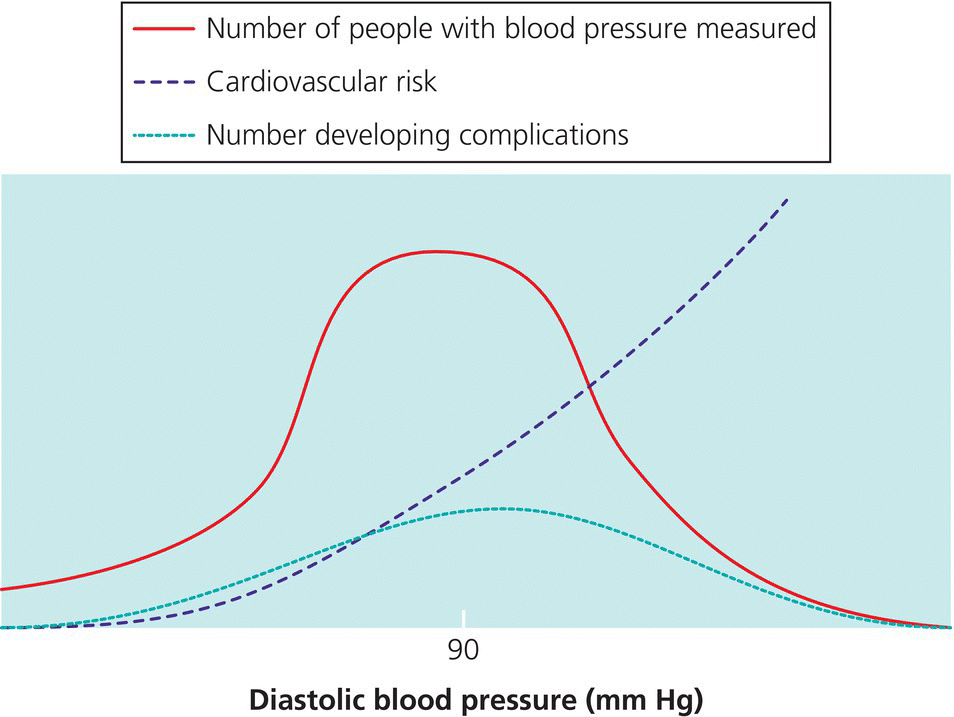
Hypertension: a disease of quantity not quality
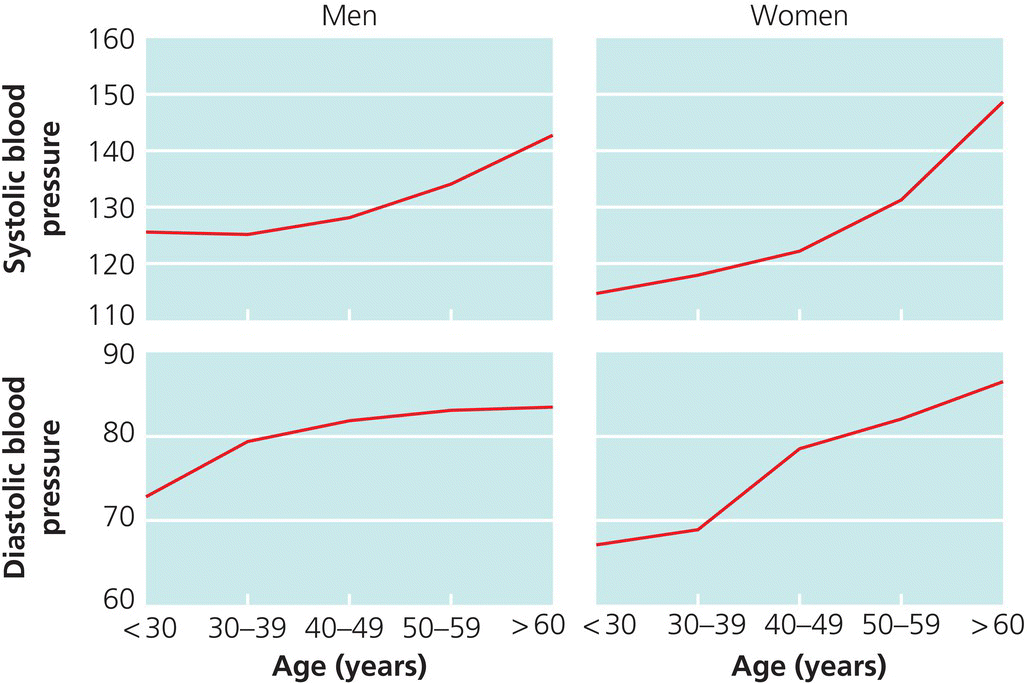
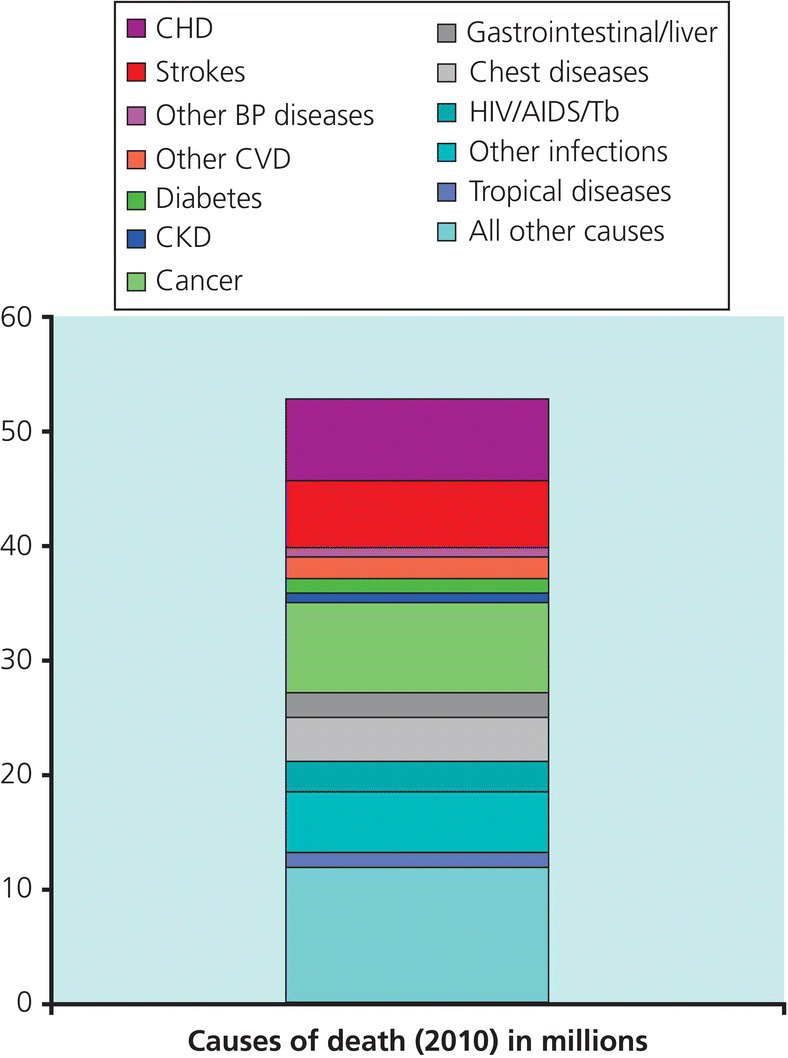
Prevalence
Population
Men (%)
Women (%)
African-Caribbean
30.8
34.4
European
19.4
12.9
South Asian
16.0
—
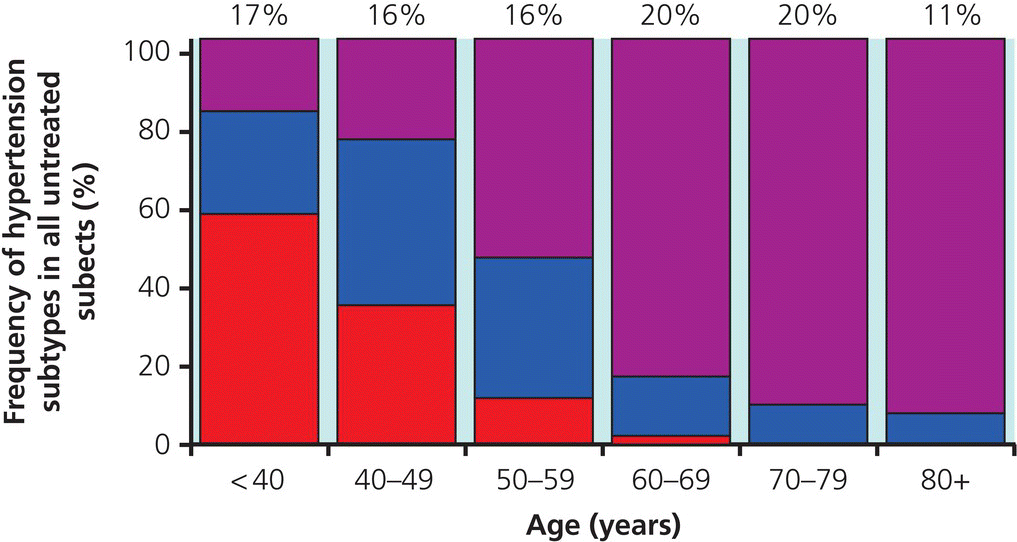
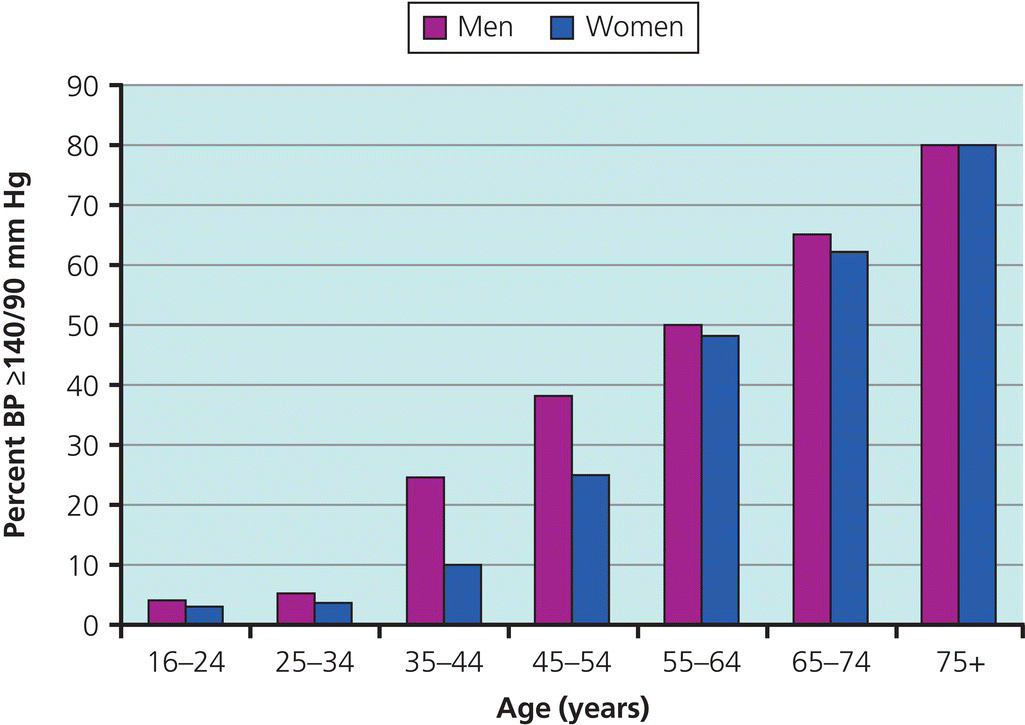
Incidence
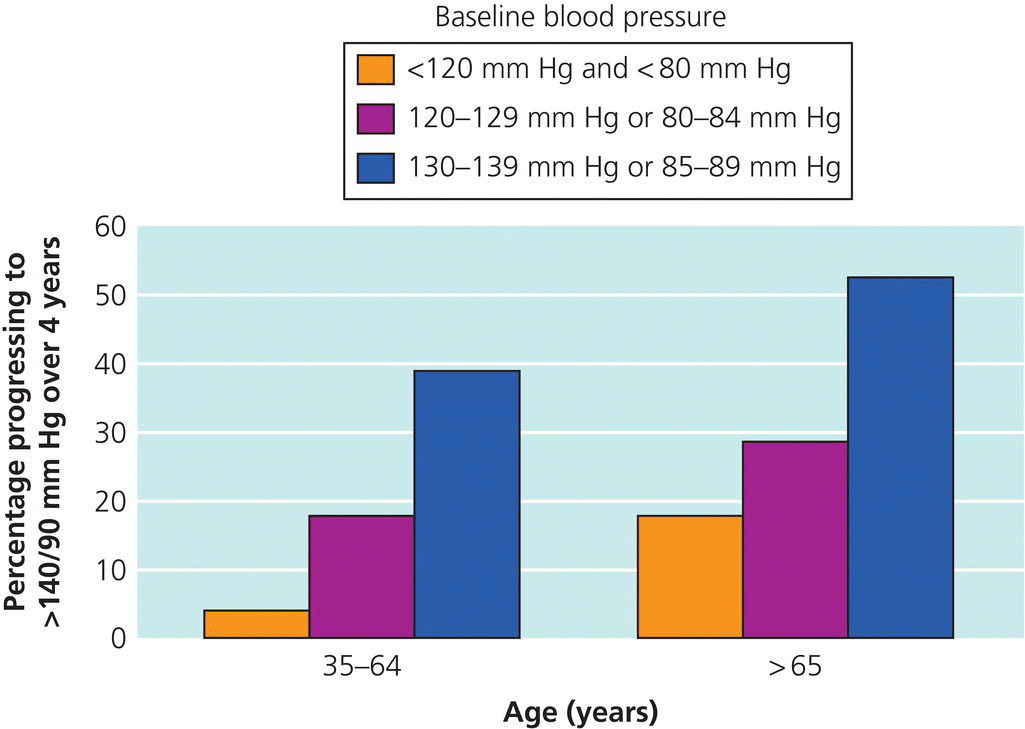
Factors affecting population blood pressure
Age
Ethnic origin
The prevalence and causes of hypertension
Source: Data from Lane, D.A., et al. (2002) Journal of Human Hypertension, 16, 267–273.
Source: Data from Agyemang, C. (2003) Journal of Human Hypertension, 17, 523–534.
< div class='tao-gold-member'>Only gold members can continue reading. Log In or Register to continue

Full access? Get Clinical Tree


